|
 Ileodictyon cibarium Ileodictyon cibarium
SynonymsClathrus cibarius
Ileodictyon giganteum
Ileodicyton cibarium var. giganteum
BiostatusPresent in region - Indigenous. Endemic
Images (click to enlarge)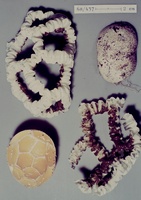
Caption: ZT68-437
Owner: E. Horak: © Creative Commons Attribution-Noncommercial 3.0 New Zealand | 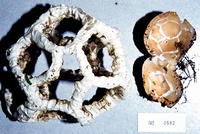
Caption: ZT0582
Owner: E. Horak: © Creative Commons Attribution-Noncommercial 3.0 New Zealand | 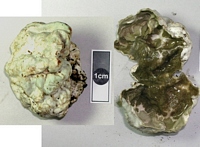
Owner: J.A. Cooper | 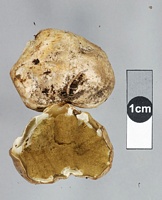
Owner: J.A. Cooper | 
Owner: J.A. Cooper | 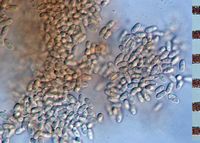
Owner: J.A. Cooper | 
Owner: J.A. Cooper | 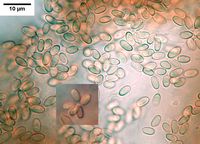
Caption: spores
Owner: J.A. Cooper | 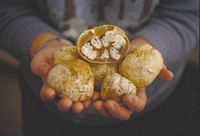
Owner: Ross Beever | 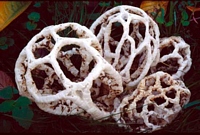
Owner: Ross Beever | 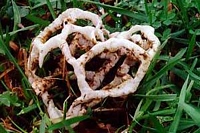
Caption: Ileodictyon cibarus
Owner: Kaimai Bush | 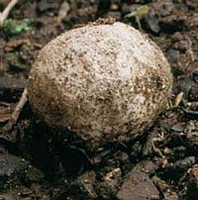
Caption: Ileodictyon cibarus
Owner: Kaimai Bush | 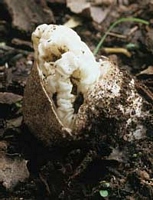
Caption: Ileodictyon cibarus
Owner: Kaimai Bush | 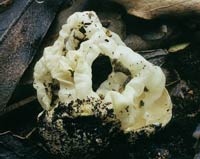
Caption: Ileodictyon cibarus
Owner: Kaimai Bush | 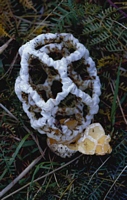
Owner: R.E. Beever | 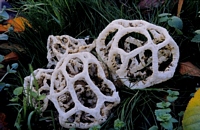
Caption: REB 1396
Owner: Ross Beever | |
Article: Cunningham, G.H. (1931). The Gasteromycetes of Australasia. XI. The Phallales, part II. Proceedings of the Linnean Society of New South Wales 56(3): 182-200.
Description: Peridium obovate or subglobose, dingy-white, to 7 cm. diameter. Receptacle sessile, white,
subglobose or commonly obovate, to 15 x 10 cm., composed of numerous obliquely
anastomosing arms, which are transversely rugulose, in section elliptical, tubular or more
often coarsely cellular, not or scarcely thickened at the interstices (though in some forms
attaining a thickness twice that of the arms). Gleba covering the inner surfaces of the arms,
olivaceous, mucilaginous, fetid. Spores tinted, elliptical, smooth, 4-6 x 1.8-2.5 µ.
Distribution: Type locality.-Waitakei, Otago, New Zealand.
Distribution. New Zealand; Australia.
Notes: This is the only Clathrus known to occur with certainty from New Zealand, where it is
exceedingly common in certain seasons, being found in spring and autumn on the edges of
forest clearings, or freshly-turned earth at roadsides or tracks cut through the forest. It occurs
sparingly in Australia, but its distribution is not certainly known since the species has been
confused by earlier workers with the following one [Clathrus gracilis]. Fischer recorded it
from Chile, West Africa (1890, p. 53) and East Africa (1893, p.19). I believe, however, that
the species is confined to this biologic region, and that Fischer has confused it with plants
later named C. Preussii, C. chrysomycelinus or C. camerunensis.
The receptacle varies greatly in size (5-15 cm.) and in the number and arrangement of the
arms. In many plants the arms are numerous, and form a close mesh, in which the polygonal
interspaces are small; in others the arms may be few and the meshes large and angular. The
arms may anastomose in such a regular manner that in plants detached from the volva it is not
possible to determine the apex from the base; or in others the arms towards the base may he
arranged in columnar fashion, or in rare cases produced to form a small basal tube-like stem.
The surfaces of the arms may be smooth, finely transversely wrinkled, or exteriorly
longitudinally grooved. In section they may be tubular or coarsely cellular, both conditions
being not infrequent in the same plant.
The receptacle is not attached to the volva in any way, consequently it may be readily
detached and carried by wind for some distance from its place of origin. The appearance of
these latticed structures without visible means of attachment to the substratum was a potent
source of mystification to the Maori. Forced to find some explanation of their (to him)
mysterious appearance, and guided no doubt by their characteristic odour he came to the
conclusion (according to Mr. Eladon Best) that they were tutae kehua or tutae whetu ("Faeces
of ghosts or of the stars"). The specific name (cibarius = edible) was applied to the species
under the impression that the unexpanded plant was used as an article of food by the Maori.
But this is improbable as it is scarcely likely he would meddle with a plant obviously (to him)
of supernatural origin. This view is supported by Mr. Best, who has advised me that the plant
was not included among those fungi considered edible by the Maori.
Article: Cooke, M.C. (1879). New Zealand fungi. Grevillea 8(46): 54-68.
|